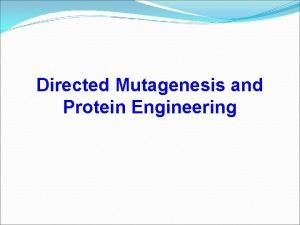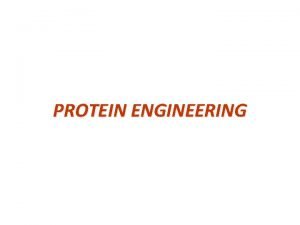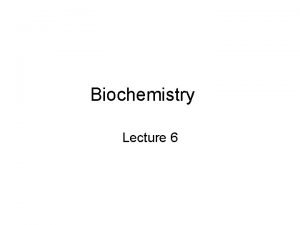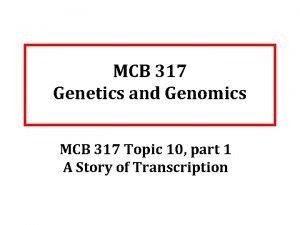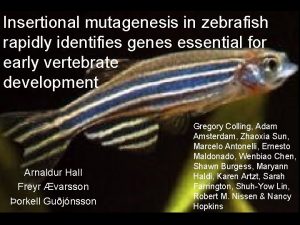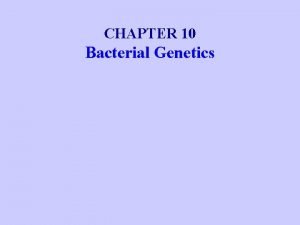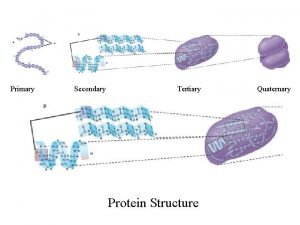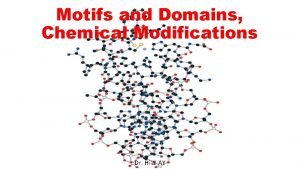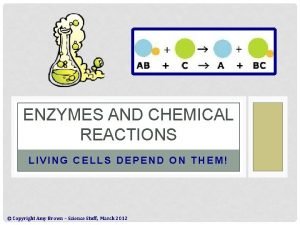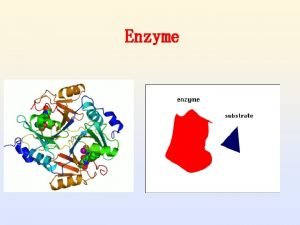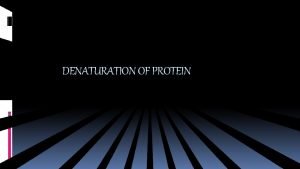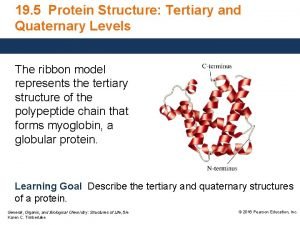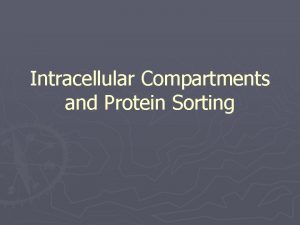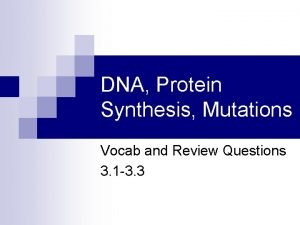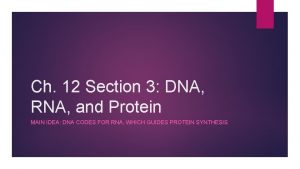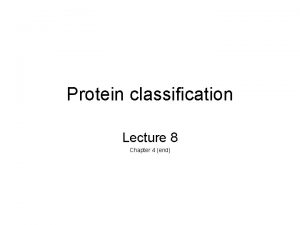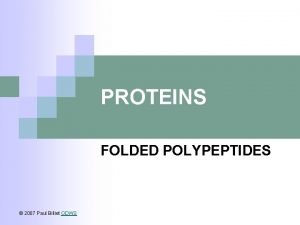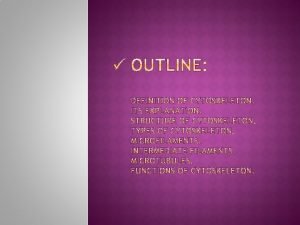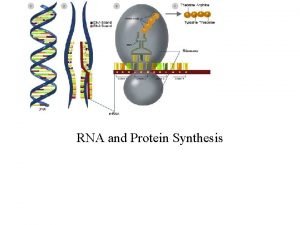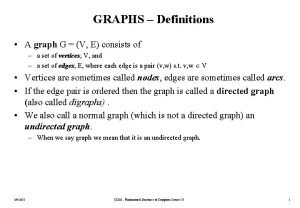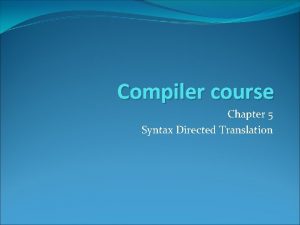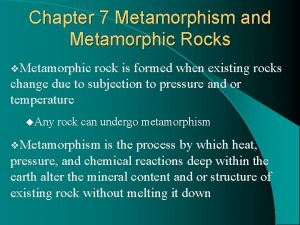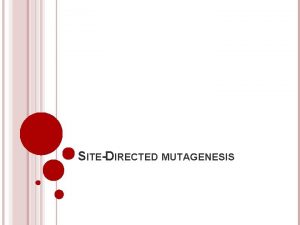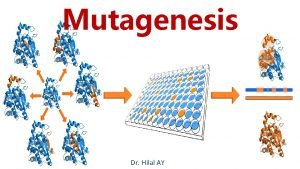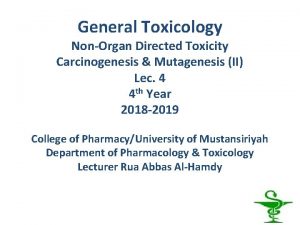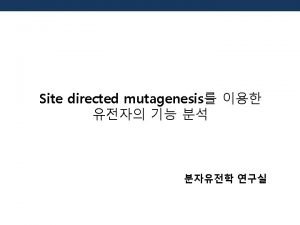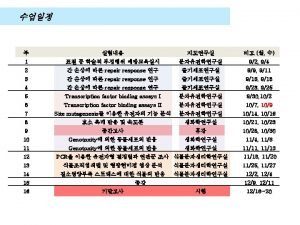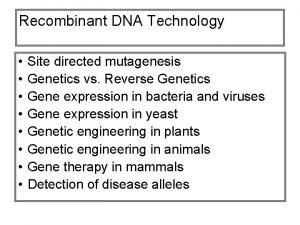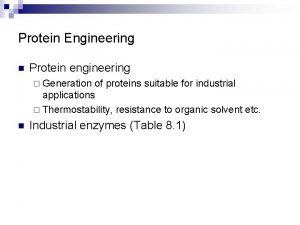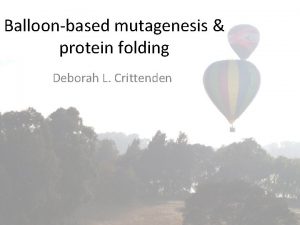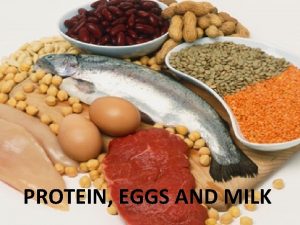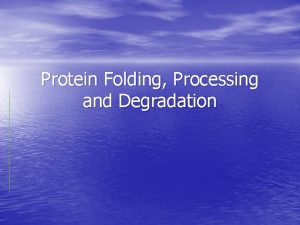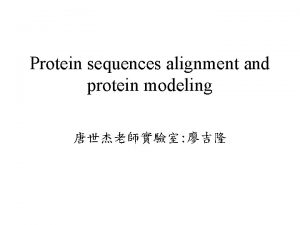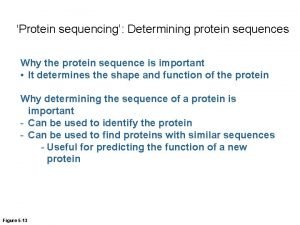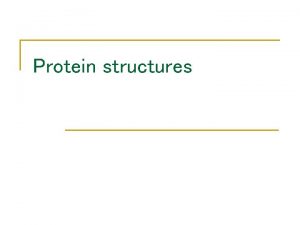Directed Mutagenesis and Protein Engineering Directed Mutagenesis Mutationrandom


































































- Slides: 66

Directed Mutagenesis and Protein Engineering

Directed Mutagenesis Mutation-random changes in the genetic material. Mutagen-an agent causing mutations. Directed mutagenesis-a process whereby specific changes are brought about in the code for a protein with the purpose of improving it for a specific application.

Directed Mutagenesis Through the techniques discussed, it is possible to clone a gene, produce the protein and analyze the results in a variety of ways. It is however only possible to produce naturally occurring proteins. These proteins may not be well suited for an industrial task.

Directed Mutagenesis The variety of enzyme properties available by searching for enzymes from organisms in extreme conditions. For example, α-amylase from Bacillus stearothermophilus or Taq polymerase from Thermophilus aquaticus. Still limited to naturally occurring proteins.

Directed Mutagenesis Km &/or Vmax Temperature or p. H stability Reactivity in non-aqueous solvents Cofactor requirements Substrate binding or specificity Stability to proteases Allosteric regulation

Directed Mutagenesis Procedures It is not a simple matter to create a new protein. However, it is quite feasible to modify the existing properties of known proteins. It can be carried out at the protein level but chemical modifications of proteins are generally harsh, non-specific, and required repeatedly, for each batch of protein. It is preferable to manipulate the DNA sequence of a cloned gene to create an altered protein. Directed mutagenesis is a trial-and-error strategy.

Directed Mutagenesis Procedures Oligonucleotide-directed mutagenesis with M 13 DNA Single-stranded bacteriophage M 13 (+ strand), carrying a cloned gene, is annealed with a complementary synthetic oligonucleotide containing one mismatched base. DNA synthesis is catalyzed by Klenow fragment of E. coli DNA polymerase I. The newly synthesized DNA is circularized by T 4 DNA ligase. The ligation mixture is used to transformed E. coli.

Oligonucleotide-directed mutagenesis with M 13 DNA Half of the produced phage will have the mutation (theoretically). The mutated clones are identified by DNA hybridization under highly stringent conditions. The original nucleotide containing mismatched sequence is used as a probe. Must know the sequence of the gene and the amino acid changes that are being introduced. Only 1% of the plaques actually contain phage carrying the mutated gene.


Oligonucleotide-directed mutagenesis with M 13 DNA One approach is to introduce M 13 viral vector carrying the gene that is to be mutagenized into an E. coli strain that has two defective enzymes. The dut mutation causes the intracellular level of d. UTP to be elevated. The ung mutation prevents the removal of any incorporated uracil residues. Following the directed mutagenesis, the cloned is used to transform wild-type E. coli. In this way, the yield of M 13 bacteriophage carrying a gene with a site-specific mutation is increased.


Oligonucleotide-directed mutagenesis with Plasmid DNA One approach is to introduce M 13 viral vector carrying the gene that is to be mutagenized into an E. coli strain that has two defective enzymes. The dut mutation causes the intracellular level of d. UTP to be elevated. The ung mutation prevents the removal of any incorporated uracil residues. Following the directed mutagenesis, the cloned is used to transform wild-type E. coli. In this way, the yield of M 13 bacteriophage carrying a gene with a site-specific mutation is increased.

Oligonucleotide-directed mutagenesis with Plasmid DNA The drawback to M 13 mutagenesis protocols is time-consuming. Clone into plasmid with a non-functional amp. R gene and a functional tet. R gene. Mutagenize with three separate primers: One primer mutates cloned gene One primer inactivates amp. R One primer reactivates tet. R Transformants are selected for ampicillin resistance and tetracyclin sensitivity. The cells with specified mutation in the target gene are identified by DNA hybridixation.


PCR-Amplified Oligonucleotide-Directed Mutagenesis PCR can be exploited both to introduce the desired mutation and to enrich for the mutated gene. This procedure uses forward and reverse PCR primers. Each pair of primers has one that is completely complimentary to a portion of our gene and one that has a single nucleotide change for point mutation. Following the PCR, a high percentage of the plasmids produced will have the desired mutation. No specific plasmids required, all we need to know is the sequence of the cloned gene.

To create deletion mutations, primers must border the region of target DNA to be deleted on both sides. To create mutation with long insertions, a stretch of miss-matched nucleotides is added to 5’ end of one or both primers.

Error-Prone PCR It is a powerful method for random mutagenesis. Taq DNA polymerase lacks proof reading activity. Adding Mn 2+, increasing the concentration of Mg 2+, and adding unequal amount of 4 d. NTPs will increase the error rate. Following the PCR, the randomly mutagenized DNA is cloned into expression vectors and screened for altered or improved protein activity. The desired cloned are then isolated and sequenced so the changes can be elaborated.

Error – prone PCR of a target gene yields a variety of mutated forms of the gene.

Random Mutagenesis with Degenerate Oligonucleotide Primers This approach is used if the protein in question is less well characterized. This approach has two advantages: The researcher does not have to know which amino acid is important or how to change it. The range of mutants produced is broad with lots of interesting possibilities. If, however, none of the mutants is a desirable one, the entire process needs to be repeated.

To start this procedure, degenerate primers are made. These are then used in PCR to generate random mutations in our gene of interest that has been cloned into a plasmid. The left and right portions of the target DNA are amplified separately by PCR. The amplified fragments are amplified, denatured to make them single stranded, and then re-annealed. Complementary regions of overlap are formed. The DNA polymerase is used to amplify the second strand then the entire fragment is amplified. The product s digested and cloned into the vector.



Random Insertion/Deletion Mutagenesis This approach is an alternative to error-prone PCR. With this approach, it is possible to: Delete a small number of nucleotides at random positions along the gene. Insert either specific or random sequences into that position. This methods is described in Fig. 8. 8.


DNA Shuffling Some proteins are encoded by a group of related genes called a gene family. It is possible using common restriction site to recombine domains from different members of the family to look for proteins with unusual characteristics. Also, some of the hybrid proteins may combine important attributes of two or more of the original proteins, e. g. , high activity and thermostability.

Random mutagenesis or error-prone PCR causes single-amino-acid substitutions. DNA shuffling, in which genes are formed with large regions from different sources.

Digestion of two or more of the DNAs that encode the native forms of similar proteins with one or more restriction enzymes that cut the DNA in the same place. Followed by ligation of the mixture of DNA fragments, a large number of hybrids are generated.

Some of the hybrid DNAs that can be generated during PCR amplification of three members of a gene family. The mixed DNA is fragmented by DNase. I, selecting smaller fragments, and PCR. Different gene fragments from a gene family will crossprime each other. It is not useful with little or no homology.


Mutant Proteins with Unusual Amino Acids Any protein can be altered by substituting one amino acid for another using directed mutagenesis. However, it is limited to the 20 amino acids. One way to increase the diversity of the proteins is to introduced synthetic amino acids with unique side chains at specific sites. It is possible using modified t. RNAs and tyrosinet. RNA synthetase to introduce unusual amino acid into mutagenesis amber stop codon. An attempt to alter the final protein activity in ways that aren’t normally possible.

Mutant Proteins with Unusual Amino Acids

Protein Engineering Of the many thousand enzymes characterized, only about 20 or so are used greatly in industrial processes. The major barrier is finding enzymes with the desired activities and well suited for a highly specialized industrial application. These naturally occurring enzymes are easily denatured by high temperature and organic solvents used in many processes.

Protein Engineering

Adding disulfide bonds There is generally a direct correlation between the number of disulfide bonds and thermo-stability of a protein. To increase stability of a variety of enzymes disulfide bonds have been added to their structure. The problem is whether extra disulfide bonds perturb the normal function.

Adding disulfide bonds T 4 lysozyme-6 variants were created using oligonucleotide-directed mutagenesis of amino acid whose R-groups were in close proximity to incorporate more cysteine residues. The variants were tested and were generally found to be more thermostable. Some variants however lacked activity. It is a trial-and-error process. However, it is clear that increasing disulfide bonds to enhance protein stability is feasible.

Adding disulfide bonds

Adding disulfide bonds Similar experiments were used to produce a more thermostable xylanase. An enzyme used in the degradation of hemicellulose, the compound generally darkens paper. The use of the variant xylanase that function efficiently at high industrial temperature allows the use of less bleach in paper production. Less pollution

Addition of a disulfide bond stabilizes the protein. Its activity is doubled at room temperature, and protected against heat inactivation.

Adding disulfide bonds RNase from bull semen has been used as an antitumorigenic agent. It is taken up into tumor cells and decreases protein synthesis by degrading r. RNA, thereby blocking protein synthesis and causing cell death. The antitumor activity is dependent on the dimeric structure. Human antibody against the bull semen Rnase are often produced. To eliminate this, human pancreatic RNase has been engineered to increase its functional life and activity using disulfide bonds.

Adding disulfide bonds

Adding disulfide bonds

Changing Asparagine to Other Amino Acids Asparagine and glutamine residues can undergo deamination at high temperature becoming aspartic and glutamic acid, respectively. The change could lead to improper folding and loss of enzyme activity. A yeast enzyme served as the model and showed increased thermostability when Asn was change to threonine and isoleucine. Similarly, a modified longer-lasting insulin was produced by changing Asp to Gly (approved for therapeutic use).

Changing Asparagine to Other Amino Acids

Reducing the Number of Free Sulfhydryl Residues In many early expression studies, the expressed protein showed much less activity than would have been predicted. Interferon showed only 10% of the antiviral activity of authentic glycosylated form. In E. coli production, the unglycosylated protein exist as dimers and higher oligomers that were inactive. Activity was greatly increased by changing different cysteines to serine.

Reducing the Number of Free Sulfhydryl Residues

Increasing Enzymatic Activity Experiments were performed using an Tyrosylt. RNA synthetase for which the active site was well characterized. A threonine at position 51 of the protein was targeted for modification. If it was replaced with an alanine, the Km of the enzyme increased 2 X without altering the rate. If it was replaced with proline, the enzyme bound ATP 100 X more tightly than normal and increased its efficiency.

Increasing Enzymatic Activity

Increasing Enzymatic Activity It is necessary to simultaneously select for the new/modified activity against the original enzyme activity. The endoprotease gene was first subjected to errorprone PCR, and modified genes were then cloned into E. coli displaying endoprotease on its surface. Two different substrates containing fluorescent dyes with Ala-Arg and Arg-Arg cleavage sites were added. After cell sorting, cells that showed both increased in green fluorescent and a decrease in red fluorescent were isolated and tested further.

Increasing Enzymatic Activity

Modifying Metal Cofactor Requirements Subtilisin was studied. This enzyme from grampositive bacteria and are widely used as biodegradable cleaning agents in laundry detergent. It requires Ca+2 as a cofactor to stabilize the enzyme. The enzyme is used in many industrial settings where there a large number of metal-chelating agents that can bind to and effectively remove calcium. These enzymes are rapidly inactivated under these conditions.

Modifying Metal Cofactor Requirements To avoid this, the portion of the enzyme required for Ca+2 binding was determined and eliminated from the protein (= inactive protein). The researchers began changing amino acids to restore enzyme activity. The result was a modified subtilisin that retains its activity but no longer requires Ca+2 ions for improved industrial use.

Modifying Metal Cofactor Requirements

Modifying Metal Cofactor Requirements

Decreasing Protease Sensitivity Demonstrated with streptokinase; a protein produced by pathogenic strain of Streptococcus bacteria that is a blood clot dissolving agent. The protein complexes with plasminogen converting it to plasmin; the protease that degrades the fibrin in a blood clot. Unfortunately, plasmin also degrades streptokinase decrease its useful life in medical treatment. A long-lived streptokinase could be administered as a single injection before a person with heart attacked is transported to a hospital.

Decreasing Protease Sensitivity Plasmin is a trypsin-like protease cleaving the peptide bond adjacent to a lysine or arginine residue. Plasmin cleaves streptokinase twice after 2 separate lysine residues, lysine 59 and lysine 386. To make streptokinase less susceptible to plasmin, the two lysine residues were changed to glutamine by oligonucleotide-directed mutagenesis. Glutamine does not have positive charge and the length of its side chain is similar to lysine thus not changing the three dimensional structure. The double mutant showed 21 X more protease resistance.


Modifying Protein Specificity Fok. I restriction enzyme from Flavobacterium okeanokoites was used as a model. It is a relatively non-specific nuclease. To add specificity to the enzyme, the portion of the gene encoding the catalytic domain was fused to another segment of DNA encoding histidine, three zinc finger domains, a linker peptide to confer flexibility. The modified enzyme was shown to recognize the expected site and to a lesser degree another two sites.

Antibodies have also been used to demonstrate this. By modifying the hypervariable regions of the protein, it should be possible to generate antibodies that are directed against a wide range of antigenic determinants. Done by introducing mutations in the hypervariable complimentarity-determining regions (CDR). Together, the six of these CDRs determine the specificity of an antibody.

Three CDR on the heavy chain were modified using random mutagenesis with mixed degenerate primers. The first PCR modified the CDR 1. The second PCR modified CDR 2 and 3. The third PCR combined the three altered CDR into a single fragment. In one instance, a Fab fragment of a monoclonal antibody that was specific for the compound 11 deoxycortisol was altered to be specific for cortisol. This approach can be used to create Fab fragments directed toward any antigenic determinant depending on the method used in screening the library.

Modifying Protein Specificity

Increasing Enzyme Stability and Specificity Tissue plasminogen activator is a serine protease useful in breaking down blood clots. Like streptokinase, it is eliminated from the body quickly by degradation. If high concentrations are given, non-specific internal bleeding can result. Thus a long-lived t. PA with increased fibrin specificity that doesn’t cause non-specific bleeding is desirable.

Three separate directed mutations were introduced to achieve these three properties. Moreover, combining these three mutations in a single construct allows all three activity to be expressed simultaneously.

Altering Multiple Properties Often changing one property often disrupts other important characteristics. Using subtilisin, DNA shuffling was used to created a large number of chimeric enzymes with unknown properties. These were tested for activity at 23˚C, thermostability, solvent stability, and p. H dependence. Of the 654 clones tested, 77 performed better than native subtilisin. This approach is called “molecular breeding. ”

The entire library is screen for protease activity. The clones that generate clear zone are selected. The chosen clones are grown under different conditions. Enzyme activity is quantified by the intensity of the color that is formed.

Peroxidase from the inky cap mushroom was also altered for use in preventing dye transfer in laundry detergent. Using a combination of oligonucleotide-directed mutagenesis, error prone PCR, and DNA shuffling, researchers produced variants with better solvent stability, p. H stability, and life span.

Altering Multiple Properties
 Directed mutagenesis and protein engineering
Directed mutagenesis and protein engineering Gene shuffling
Gene shuffling Glycosidic bond
Glycosidic bond Site directed mutagenesis
Site directed mutagenesis Syntax of mkleaf is
Syntax of mkleaf is Insertional mutagenesis
Insertional mutagenesis Insertional mutagenesis
Insertional mutagenesis Mutagenesis definition biology
Mutagenesis definition biology Mutagénesis dirigida
Mutagénesis dirigida Carrier vs channel proteins
Carrier vs channel proteins Protein-protein docking
Protein-protein docking Forward engineering and reverse engineering
Forward engineering and reverse engineering System architecture example
System architecture example Dicapine
Dicapine Engineering elegant systems: theory of systems engineering
Engineering elegant systems: theory of systems engineering Reverse engineering vs forward engineering
Reverse engineering vs forward engineering Veterans directed home and community based care
Veterans directed home and community based care Receiving and put-away
Receiving and put-away Directed numbers examples
Directed numbers examples Directed paraphrasing
Directed paraphrasing Veterans directed home and community based care
Veterans directed home and community based care Reported speech later
Reported speech later Section 12-3 rna and protein synthesis
Section 12-3 rna and protein synthesis Protein characterization methods
Protein characterization methods Primary secondary and tertiary protein structure
Primary secondary and tertiary protein structure Protein domains and motifs
Protein domains and motifs Enzymes affect reactions in living cells by changing the
Enzymes affect reactions in living cells by changing the Why are enzymes so important?
Why are enzymes so important? Characteristics of denatured protein
Characteristics of denatured protein Primary secondary and tertiary protein structure
Primary secondary and tertiary protein structure Missense mutation in sickle cell anemia
Missense mutation in sickle cell anemia Intracellular compartments and protein sorting
Intracellular compartments and protein sorting Protein synthesis and mutations
Protein synthesis and mutations Protein synthesis and mutations
Protein synthesis and mutations Chapter 12 section 3 dna rna and protein
Chapter 12 section 3 dna rna and protein Identify some food sources of lbv and hbv proteins.
Identify some food sources of lbv and hbv proteins. Rna and protein synthesis study guide
Rna and protein synthesis study guide Protein definition and classification
Protein definition and classification Primary secondary and tertiary structure of protein
Primary secondary and tertiary structure of protein Fruits, grains vegetables protein and dairy
Fruits, grains vegetables protein and dairy Microfilament functions
Microfilament functions Section 12 3 rna and protein synthesis
Section 12 3 rna and protein synthesis Vector addition properties
Vector addition properties Child directed speech definition
Child directed speech definition Input string
Input string Riasec interpretation
Riasec interpretation Self directed search holland
Self directed search holland Romeo and juliet summary act 5
Romeo and juliet summary act 5 Freud's personality theory
Freud's personality theory Goal directed personas
Goal directed personas How are metamorphic rocks classified
How are metamorphic rocks classified Properties of directed acyclic graph
Properties of directed acyclic graph Lvn scope of practice texas
Lvn scope of practice texas Self directed play
Self directed play G+ve
G+ve The monitor hypothesis
The monitor hypothesis Dart: directed automated random testing
Dart: directed automated random testing Application of syntax directed translation
Application of syntax directed translation Dynamothermal
Dynamothermal Goal-directed design
Goal-directed design Direct motion specification in computer graphics
Direct motion specification in computer graphics Self directed play
Self directed play Positive number definition
Positive number definition Partition point formula
Partition point formula Ratio midpoint formula
Ratio midpoint formula Directed number example
Directed number example Directed number exercise
Directed number exercise
